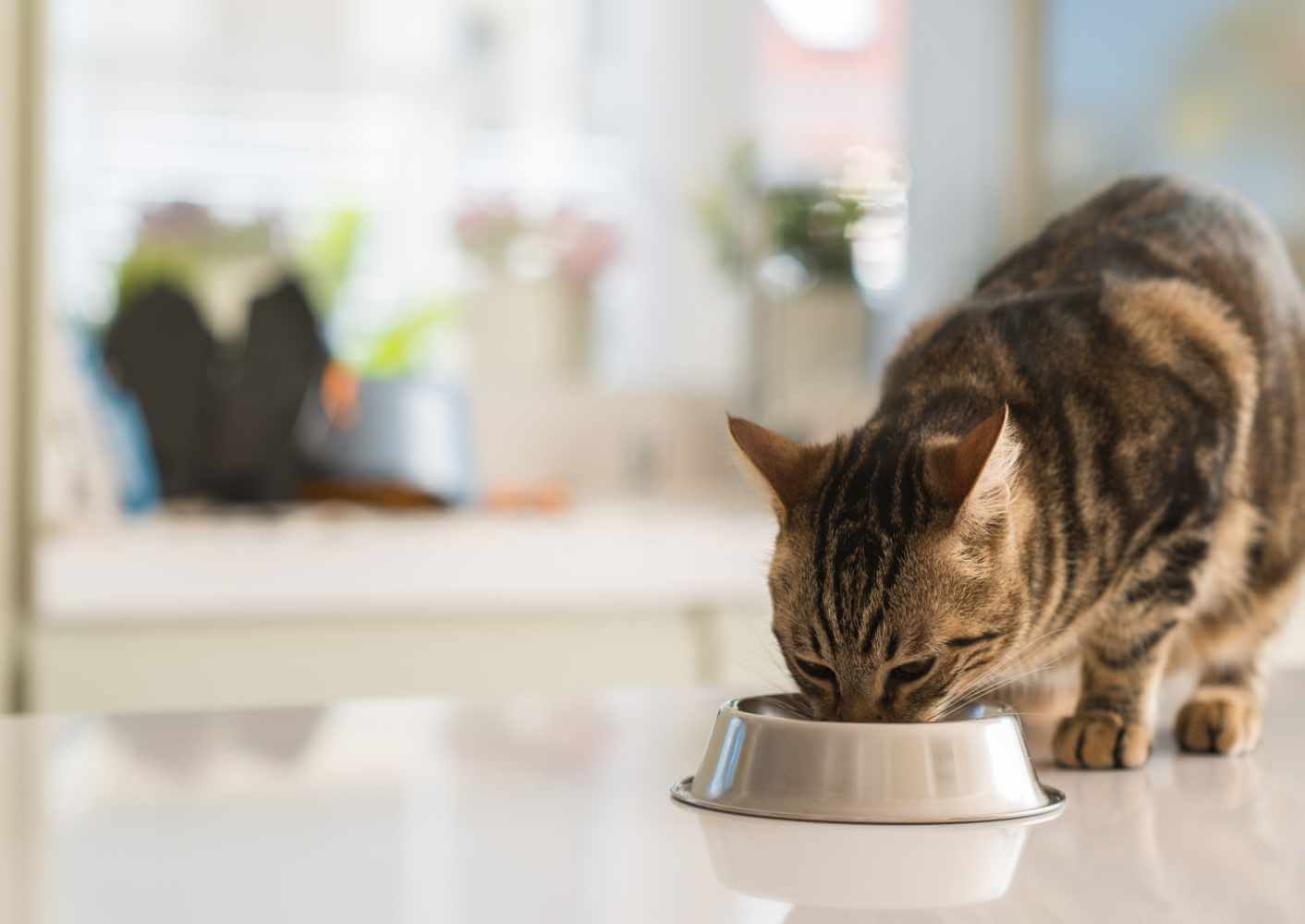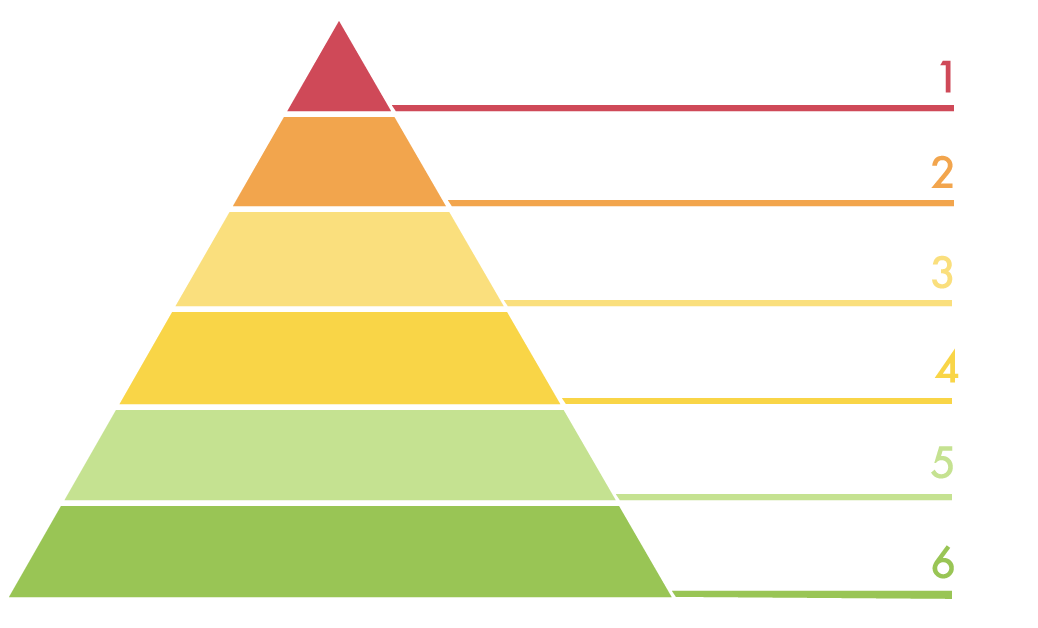These are the nutrients your cat needs
As carnivores, cats are completely specialised in animal food and the nutrients it contains: both the cat's teeth and its digestive system and metabolism are geared to cutting up and processing meat. If a cat has to feed itself, small vertebrates such as mice are particularly important. Between 10 and 20 of these small rodents are consumed daily, which is enough to meet the cat's entire nutritional needs, including its water and fibre requirements. Since cats absorb fluids mainly through food, they drink very little. Fibre is found in the stomachs of their prey - in the form of pre-digested plant remains.
But what can't our carnivorous house cats do without? Read on to find out more.


Nutrient pyramid:
1: Vitamins
2: Minerals
3: carbohydrates
4: supplements rich in crude fibre
5: fats
6: animal proteins
The most important nutrients in a cat's diet
The most important nutrients - the so-called macronutrients - provide energy and building materials. These are carbohydrates, proteins and fat. However, cats hardly need carbohydrates - they ingest them indirectly in small quantities via their prey. In this respect, their tolerance for the utilisation of carbohydrates is low.
There are also micronutrients: minerals (bulk and trace elements) and vitamins (water-soluble and fat-soluble). In principle, they do not provide the body with energy, but in smaller quantities they are absolutely essential for your pet's physical functions. The mouse, the typical prey of a wild cat, consists of about 65 per cent water. The remainder (dry content) is about 50 to 60 per cent protein, 20 to 30 per cent fat, three to eight per cent carbohydrates and 6 to 8 per cent minerals - this is the standard for a species-appropriate cat diet.
Growing cats, pregnant and nursing cats and older animals have different nutritional requirements. You should consult your vet to ensure that your cat's diet meets its needs.
The nutritional pyramid for healthy adult cats provides information on the ratio between the individual nutrients.
Proteins
Proteins are naturally occurring substances that consist exclusively or predominantly of amino acids. Their main function is the formation and maintenance of body substances and the building of muscles. Animal proteins play the main role in cat nutrition.
The amino acids essential for cats are found in particular in muscle meat, heart, poultry and fish as well as in eggs. Offal, connective tissue, cartilage, tendons and skin also contain proteins, but cats cannot use them optimally. Your velvet paw needs about four to five grams of high-quality proteins per kilogram of body weight per day.
Caution: Growing cats, cats during pregnancy and lactation have a higher protein requirement! You should therefore have the food rations calculated by experts.
Fats
Animal fats are another important nutrient for cats. The organism converts them into glycerine and fatty acids: Glycerol provides the cat with energy and the fatty acids promote a healthy immune system and digestion. Examples of typical fats are beef tallow or goose fat. Oils can be obtained from various plants (e.g. olive oil, evening primrose oil, hemp oil, etc.) or from fish (e.g. salmon oil). Fish oils are particularly recommended for cats due to their high content of essential fatty acids.
Linoleic acid as an essential fatty acid must be taken in through food, because the cat cannot produce it itself. It ensures healthy skin and coat. Another essential fatty acid is arachidonic acid, which cats cannot synthesise themselves due to an enzyme deficiency and must also be ingested with food. It is particularly important for the metabolism. Linolenic acid keeps cell membranes intact, ensures the proper functioning of the central nervous system and strong defences. Cats can produce this amino acid from linoleic acid.
Dietary fibre / supplements rich in crude fibre
Dietary fibres are vegetable fibres that have a positive effect on digestive processes and are therefore a sensible addition to the bowl.
Particularly rich in raw fibres are, for example, feed cellulose or wheat bran. requirement: approx. 1-2 g per kg body mass.
- Vegetables: raw and finely grated, blanched, mashed.
- possibly herbs
Carbohydrates
Carbohydrates and starch are difficult for cats to digest because they lack a special enzyme in their saliva that breaks down starch. Their need for starch is correspondingly low, as is their tolerance threshold for its utilisation. Wheat or the gluten it contains can lead to intolerances and should therefore not be included in cat food.
For production reasons, dry food may contain higher amounts of carbohydrates. The starch is therefore broken down during production and made digestible. Wet food should therefore be given in preference to dry food - also because cats mainly cover their fluid requirements through food.
Minerals
Minerals can be divided into bulk and trace elements based on the amount needed by the body - they are involved in almost all processes in the body.
The bulk elements calcium and phosphorus, magnesium, sodium and potassium are particularly important for cats. Calcium and phosphorus must be in a ratio of 1:1. This way they complement each other optimally and strengthen bones and teeth.
The trace elements iron, manganese, zinc, copper and selenium play an important role in a functioning metabolism.
- Meat provides phosphorus and zinc, but little calcium and other minerals.
- Offal/organs: Heart, liver, kidney, stomach, rumen (green and white) provide copper, iron and selenium. Offal is less digestible for cats than muscle meat.
- Fish: Iodine
- Dairy products: They are easily digestible and valuable sources of calcium.
The smooth functioning of the metabolism is made possible by vitamins, among other things - they increase resistance and protect the cells. A distinction should be made between fat-soluble (A, D, E, K) and water-soluble vitamins (B group, C) - all are vital for your cat. Note the limited amount of vegetables and fruit that cats will accept - so this should never be the main source of vitamins.
Fat-soluble vitamins include:
- Vitamin A (e.g. in: heart, liver, kidney, stomach, green and white rumen).
- Vitamin D (e.g. in: eggs)
- Vitamin E (e.g. in: vegetable oils, meat)
- Vitamin K (e.g. parsley, chives, calf's liver)
The functions of vitamins are manifold - among others they are involved here:
- Bone metabolism
- Skin and hair health
- Vision
- Immune system
What happens if there is an undersupply or oversupply?
A deficiency or over-supply of nutrients can lead to diseases, so it is important for you as an owner to inform yourself about the exact needs of your animal - your most important contact person should always be the vet.
Undersupply of proteins (amino acids):
- Cats cannot produce the amino sulphonic acid taurine with the body's own metabolism. Taurine is important for the synthesis of bile salts and is therefore added to cat food in the production process. A deficiency can lead to eye or heart disease and fertility problems.
- High arginine requirement: This essential amino acid is important for the urea cycle. An undersupply can result in ammonia poisoning in the cat. Arginine is usually available in sufficient quantities in meat.
- Iodine is a component of thyroid hormones. An excess of iodine leads to hyperthyroidism (common disease in older cats).
- Iron (oxygen transport): Does your cat have pale mucous membranes and is weak and tired? Then she may have an iron deficiency.
Over- and undersupply of vitamins:
- Excessive liver feeding can lead to an excess of vitamin A (hypervitaminosis A).
- Most feeds contain little vitamin K. However, the bacteria of the normal intestinal flora produce vitamin K, so that a deficiency only occurs when this intestinal flora is out of balance (e.g. in diarrhoeal diseases).
- The water-soluble vitamins are simply excreted in the urine if too much is taken in. An over-supply is therefore impossible in comparison to the fat-soluble vitamins.
- If your cat vomits, is very skinny and even seems disoriented, it may have a vitamin B1 deficiency.
- Vitamin B6 deficiency: promotes urinary stones Lack of biotin (or vitamin B7): promotes skin problems
- Cats can produce vitamin C in their liver, so it is not necessary to give it to them to strengthen their immune system. They simply excrete it unused in their urine.

